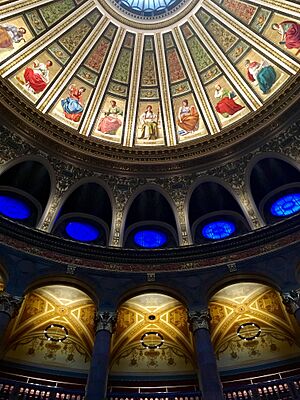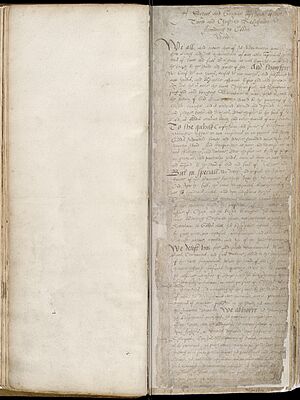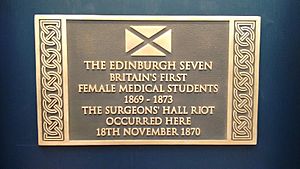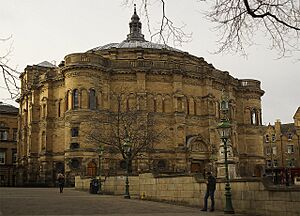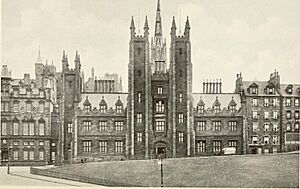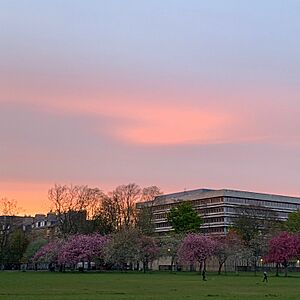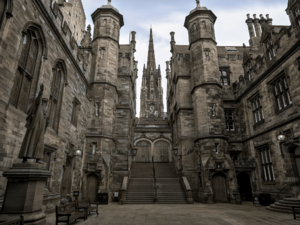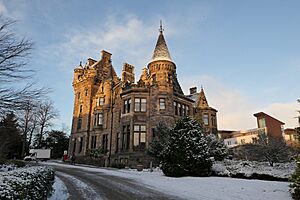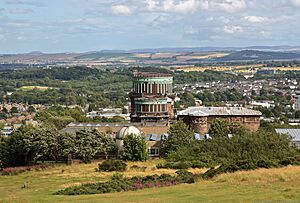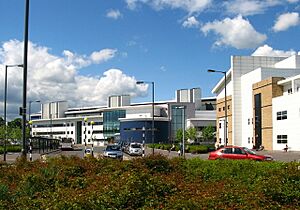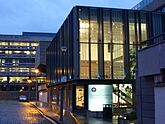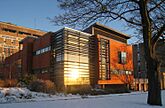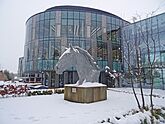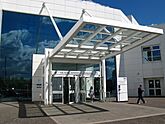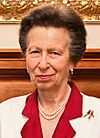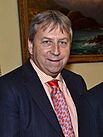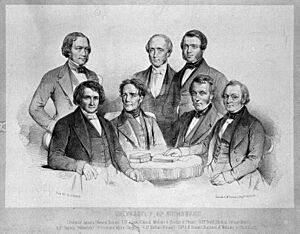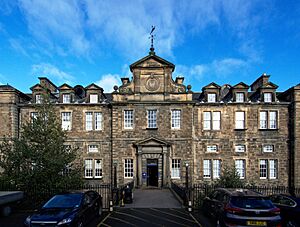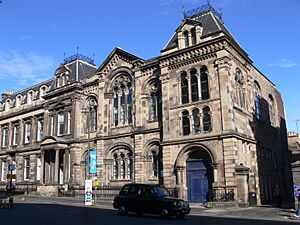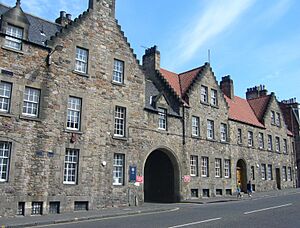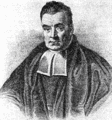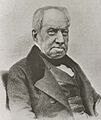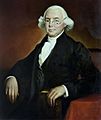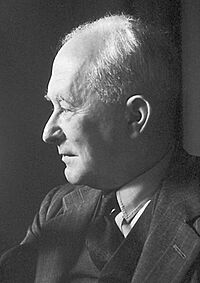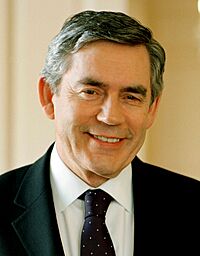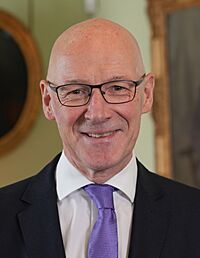University of Edinburgh facts for kids
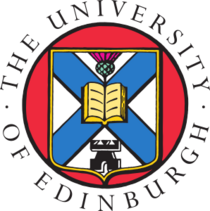 |
|
| Latin: Universitas Academica Edinburgensis | |
|
Former names
|
Tounis College King James' College |
|---|---|
| Type | Public research university Ancient university |
| Established | 1583 |
|
Academic affiliation
|
|
| Endowment | £580.4 million (2024) |
| Budget | £1.386 billion (2023/24) |
| Chancellor | Anne, Princess Royal |
| Rector | Simon Fanshawe |
| Principal and Vice-Chancellor | Sir Peter Mathieson |
|
Academic staff
|
5,401 FTE (2024) |
|
Administrative staff
|
7,207 FTE (2024) |
| Students | (2015/16) 36,260 FTE (2015/16) |
| Undergraduates | (2015/16) |
| Postgraduates | (2015/16) |
| Location |
,
Scotland, UK
55°57′N 3°11′W / 55.950°N 3.183°W |
| Campus | Urban, suburban |
| Colours | Red Blue |
 |
|
The University of Edinburgh is a public university in Edinburgh, Scotland. It was started by the town council with permission from King James VI in 1582. The university officially opened in 1583. It is one of Scotland's four oldest universities and the sixth-oldest university that has been open continuously in the English-speaking world. The university was very important in making Edinburgh a top place for new ideas during the Scottish Enlightenment. This led to the city being called the "Athens of the North".
The University of Edinburgh is often ranked among the top 40 universities in the world by major global rankings. It is part of several groups of universities that focus on research, like the Russell Group. In the year ending July 2024, the university had a total income of £1.386 billion. A big part of this came from research projects. It has the third-largest amount of money saved (called an endowment) in the UK, after only Cambridge and Oxford. The university has five main areas in Edinburgh, with many old and beautiful buildings.
Edinburgh is the fourth-largest university in the UK by the number of students. It is the second-largest in Scotland. Each year, it gets over 66,000 applications from students wanting to study there. This makes it one of the most popular universities in the UK. The university has strong connections to the royal family. Prince Philip, Duke of Edinburgh was its chancellor from 1953 to 2010. Anne, Princess Royal has held this position since March 2011.
Many famous people have studied at the University of Edinburgh. These include Alexander Graham Bell, who invented the telephone, and Charles Darwin, who developed the theory of evolution. Other notable alumni are philosopher David Hume, physicist James Clerk Maxwell, and writers like Sir Arthur Conan Doyle (who created Sherlock Holmes) and Robert Louis Stevenson. The university has also educated several leaders of countries, including three British prime ministers. As of October 2024, 20 Nobel Prize winners have been connected to the university.
Contents
University History: A Journey Through Time
How the University Started
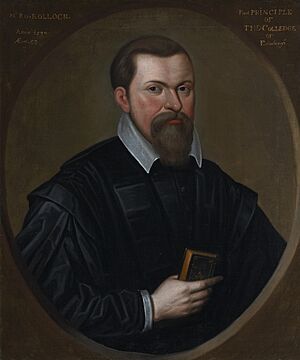
In 1557, a bishop named Robert Reid left money in his will to build a college in Edinburgh. He wanted it to teach subjects like public speaking and poetry, which was unusual for his time. However, religious changes in Scotland delayed these plans for over 25 years. In the late 1570s, the Edinburgh Town Council and others worked to bring the idea back. King James VI gave his permission for the college to be built on April 14, 1582. This was special because other Scottish universities were started by the Pope, but this one was started by local leaders.
The university was first called Tounis College (Town's College). It opened on October 14, 1583, with about 80 to 90 students. At first, it mainly taught liberal arts and religious studies. Robert Rollock, a graduate from another university, was the first teacher and later the principal. He taught the first group of students for all four years of their degree. In 1587, 47 students were the first to graduate with a Master of Arts degree. When King James VI visited in 1617, he said the college should be called "Colledge of King James." Over time, it became known as the University of Edinburgh.
Changes in the 1700s and 1800s
In the early 1700s, the university and the town council had disagreements about who was in charge. Things slowly got better over the next 150 years. In 1708, Principal William Carstares changed how the university was run. He created a system with different professors for different subjects, like in Dutch universities. The university grew, adding a Law department in 1707, an Arts department in 1708, and a Medicine department in 1726. In 1762, King George III appointed the first professor of English Literature, making Edinburgh the oldest place in Britain to formally teach literature.
During the 1700s, the university was a key part of the Scottish Enlightenment. This was a time when many new ideas in science, philosophy, and economics came from Scotland. Because the university was started by local authorities and not the church, it was more open to new ways of thinking. It also had a flexible system of professors, which encouraged new ideas. Many important thinkers taught here, such as chemist Joseph Black and economist Adam Smith. By 1783, the university was seen as one of the best science places in the world. Voltaire even called Edinburgh a "hotbed of genius."
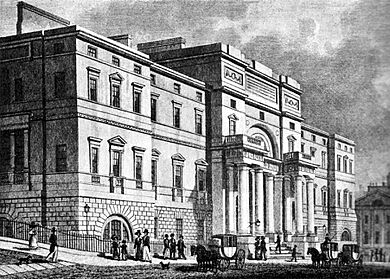

In 1785, a new law helped the university build its first custom-made building, Old College. Before this, the university was spread out in many different buildings. The Old College was designed by architect Robert Adam. In the 18th century, the university became very good at teaching anatomy and surgery. It was considered one of the best medical schools. Bodies for study were brought to the university through a secret tunnel from a nearby house.
In 1838, students had a big snowball fight that turned into a two-day "battle" with local residents. This event was later captured in a humorous story and a painting. After 275 years, a new law in 1858 gave the university full control over its own matters.
The Edinburgh Seven were the first group of women to officially enroll as university students in Britain. Led by Sophia Jex-Blake, they started studying medicine at Edinburgh in 1869. Even though the university stopped them from graduating as doctors at the time, their efforts brought national attention to women's rights in higher education. This led to a law in 1889 that allowed women to study at all Scottish universities. The university finally allowed women to graduate in medicine in 1893. In 2019, these seven women were given their medical degrees after they had passed away, honoring their bravery.
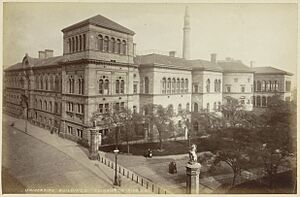
By the late 1800s, Old College was getting too crowded. New buildings were planned, and the new Medical School opened in 1884. The McEwan Hall, a separate building for graduations, was finished in 1897.
The Students' Representative Council (SRC) was started in 1884. In 1889, the Edinburgh University Union (EUU) was created, located in Teviot Row House. This building is the oldest purpose-built student union building in the world.
The 1900s and Beyond
During World War I, the science and medicine buildings needed repairs. After the war, many more students joined. In 1919, the university bought land south of the city to build a new campus for science. This campus was named King's Buildings in honor of King George V.
New College became the home of the School of Divinity in the 1930s. This freed up Old College for the Edinburgh Law School.
The Polish School of Medicine was set up in 1941 during World War II. It taught medicine in Polish and gave Polish medical degrees. When it closed in 1949, many students had graduated. A plaque at the old Medical School remembers this special school.
In 1951, the Royal (Dick) Veterinary College became part of the university. In 1955, the university opened the first department in Europe for studying nursing at an academic level.
By the end of the 1950s, student numbers had more than doubled to about 7,000 each year. To make space, the university redeveloped George Square, building modern buildings like the Main Library. In 1998, the Moray House Institute of Education joined the university, becoming the Moray House School of Education.
Recent Developments
In the 1990s, the old hospital buildings were no longer suitable. A new hospital and medical campus, called the BioQuarter, opened in 2002. It houses the new Edinburgh Medical School. In 2010, author J. K. Rowling helped fund a clinic for nerve diseases. The Centre for Regenerative Medicine (CRM), a stem cell research center, opened in 2012.
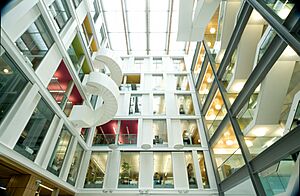
In 2002, a fire destroyed some university buildings. These were replaced by the Informatics Forum in 2008. Also in 2002, the Edinburgh Cancer Research Centre (ECRC) opened. In 2008, the Roslin Institute, famous for cloning Dolly the sheep, became part of the university's veterinary school.
Edinburgh College of Art joined the university in 2011. In 2014, the university started a joint institute with Zhejiang University in China, offering degrees in biomedical sciences. The university also started hosting a Wikimedian in Residence in 2016, who helps with teaching and learning using Wikipedia.
In 2018, the university joined a big project called the Edinburgh and South East Scotland City Region Deal. This project aims to bring economic benefits to the region through data-driven innovation. It created five new innovation centers. In 2024, the Edinburgh Futures Institute (EFI) opened in a restored historic building, focusing on solving complex societal challenges.
University Connections Around the World
Edinburgh University has many historical connections to other universities, especially through its Medical School. Its graduates helped start and develop institutions worldwide. For example:
- Columbia University: Its Medical School was founded by Samuel Bard, an Edinburgh graduate.
- Dalhousie University: Modeled after Edinburgh, it was founded by Edinburgh alumnus George Ramsay.
- Harvard University: Its Medical School was founded by three surgeons, one of whom was Benjamin Waterhouse, an Edinburgh alumnus.
- University of Pennsylvania: Its Medical School was founded by Edinburgh graduate John Morgan, who based it on Edinburgh's.
- Yale University: Its Medical School was co-founded by Nathan Smith, an Edinburgh alumnus.
University Locations and Buildings
The university has five main locations in Edinburgh:
- Central Area
- King's Buildings
- BioQuarter
- Easter Bush
- Western General
The university owns many important historic and modern buildings. These include St Cecilia's Hall, Scotland's oldest concert hall, and Teviot Row House, the oldest student union building in the world.
Central Area Campus

The Central Area is the oldest part of the university. It is mostly used by the College of Arts, Humanities and Social Sciences. Many university buildings are around George Square. This includes the Main Library and the largest lecture hall, Gordon Aikman Lecture Theatre. Near Bristo Square are buildings like the McEwan Hall and the old Medical School. Old College houses the Edinburgh Law School. Many of these buildings are used for events during the Edinburgh festivals in summer.
Pollock Halls Student Residences
Pollock Halls is the university's largest place for first-year undergraduate students to live. It has over 2,000 students during term time. The complex has ten buildings and green spaces. Some of the older buildings date back to the 1800s. The area also has a conference center.
Holyrood Campus
The Holyrood campus is near the Royal Mile. It used to be the Moray House Institute for Education before it joined the university in 1998. This campus has sports facilities and student housing for postgraduate students.
King's Buildings Campus
The King's Buildings campus is in the south of the city. Most of the science and engineering research and teaching happens here. It covers a large area and includes buildings for mobile phones, physics, chemistry, and engineering. The campus also has the Royal Observatory. A new library, the Noreen and Kenneth Murray Library, opened here in 2012.
BioQuarter Campus
The BioQuarter campus is home to most of the university's medical facilities. It is next to the Royal Infirmary of Edinburgh hospital. This campus has research centers for nerve diseases and regenerative medicine.
Easter Bush Campus
The Easter Bush campus is seven miles south of the city. It houses the Royal (Dick) School of Veterinary Studies and the Roslin Institute.
The Roslin Institute is famous for animal science research. In 1996, its researchers cloned Dolly the sheep, the first mammal cloned from an adult cell.
Western General Campus
The Western General campus is near the Western General Hospital. It has facilities for biomedical research and genetics.
- Modern architecture at the University of Edinburgh
-
Royal Infirmary of Edinburgh, School of Medicine
How the University is Run
University Leadership
The university has three main leaders: the chancellor, the rector, and the principal.
The chancellor is the head of the university in name. Their job is to give out degrees and help the university's reputation. The chancellor is chosen by the university's graduates and usually stays in the role for life. Princess Anne has been the chancellor since March 2011.
The principal is like the chief executive officer, managing the university's daily operations. They are in charge of academic work and also act as the vice-chancellor, giving out degrees for the chancellor. The current principal is Sir Peter Mathieson.
The rector is chosen every three years by staff and students. The rector leads meetings of the University Court and works closely with students. Famous past rectors include Sir Winston Churchill. The current rector is Simon Fanshawe.
University Colleges and Schools
In 2002, the university changed its structure from nine departments to three main 'Colleges'. These are the Colleges of Arts, Humanities and Social Sciences (CAHSS), Science & Engineering (CSE), and Medicine & Vet Medicine (CMVM). Inside these colleges are 'Schools' that focus on specific subjects like Informatics or groups of subjects like History. The university has 21 schools in total.
Arts, Humanities and Social Sciences
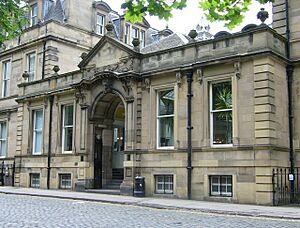
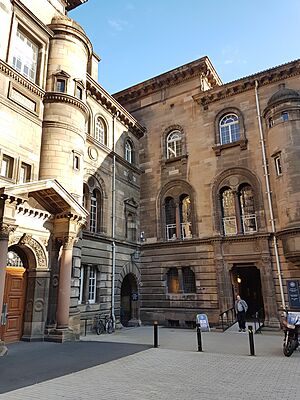
This college offers many different degree programs for undergraduate and postgraduate students. It includes the oldest English Literature department in Britain. The college is the largest of the three, with over 26,000 students.
Medicine and Veterinary Medicine
Edinburgh Medical School was considered the best medical school in the English-speaking world for a long time. Its graduates started medical schools all over the world, including at five of the seven Ivy League universities in the US. In recent years, the medical school has continued to be highly ranked. It is connected to 13 Nobel Prize winners. The Royal (Dick) School of Veterinary Studies is also a world leader in veterinary education. This college is the smallest of the three, with about 7,700 students.
Science and Engineering
In the 1500s, science was taught as "natural philosophy." Over time, the university added professors for subjects like Mathematics, Botany, Astronomy, and Chemistry. In 1783, Edinburgh professors helped create the Royal Society of Edinburgh. The first science degrees were given in 1864, and a separate Faculty of Science was created in 1893. This college has about 11,700 students.
Specialized Centers and Institutes
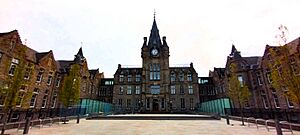
The university has many special centers and institutes for research and learning. Some examples include:
- Bayes Centre (for data science and artificial intelligence)
- Centre for Regenerative Medicine (CRM) (for stem cell research)
- Edinburgh Futures Institute (EFI) (for interdisciplinary studies)
- Roslin Institute (for animal science research, famous for Dolly the sheep)
Student Life at Edinburgh University
Students' Association
The Edinburgh University Students' Association (EUSA) is made up of the student union and the student representative council. EUSA has buildings like Teviot Row House, which is the oldest purpose-built student union building in the world. These buildings have shops, cafes, and spaces for students. EUSA helps represent students to the university and supports over 250 student clubs and societies.
Debate and Performing Arts
The University of Edinburgh is home to The Diagnostic Society of Edinburgh, founded in 1787. It claims to be the oldest student debating society in the UK.
Edinburgh is a big cultural center for comedy and theater, especially during the Edinburgh Festival Fringe. Student drama groups benefit from this. The Edinburgh University Music Society (EUMS) is Scotland's oldest student music society, performing concerts throughout the year. The Edinburgh University Theatre Company (EUTC) runs Bedlam Theatre, the oldest student-run theater in Britain.
Student Media
The Student is a student newspaper published every two weeks. It was started in 1887 by writer Robert Louis Stevenson and is the oldest student newspaper in the UK. Famous former writers include politicians Gordon Brown and Robin Cook.
FreshAir is a student radio station that started in 1992. It is one of the oldest student radio stations in the UK. Edinburgh University Student Television (EUTV) started in 2015, producing shows and documentaries.
Sports and Athletics
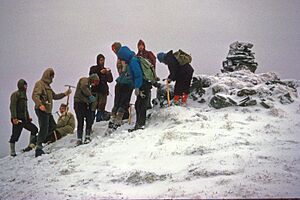
Students at Edinburgh can join over 65 sports clubs. These include traditional sports like rugby and rowing, as well as unique ones like korfball and mountaineering.
The Scottish Varsity is a rugby match played every year against the University of St Andrews. It is known as the "world's oldest varsity match," dating back over 150 years. Since 2015, it has been played at Murrayfield Stadium in Edinburgh.
The Scottish Boat Race is an annual rowing race between Edinburgh and Glasgow University Boat Club. It is believed to be the third-oldest university boat race in the world.
Edinburgh athletes have won many medals at the Olympic Games. Sprinter Eric Liddell won gold in 1924. Cyclist Sir Chris Hoy won six gold medals between 2000 and 2012. Rower Dame Katherine Grainger won a gold medal in 2012.
Student Activism
The university has many student groups that campaign for different causes. These include environmental groups and human rights organizations like Amnesty International Society. There are also groups focused on social justice and equality.
Students often hold protests and demonstrations at the university. In May 2024, students set up a protest camp to raise awareness about global conflicts and the university's investments. The university stated it would respect peaceful protest rights and reviewed its investment policies.
Student Co-operatives
There are three student-run co-operatives linked to the university. These are the Edinburgh Student Housing Co-operative (ESHC), which provides affordable housing, the Hearty Squirrel Food Cooperative, which offers local and organic food, and the SHRUB Coop, which helps reduce waste.
Famous People from Edinburgh University
The university is connected to many important discoveries and ideas in history. These include:
- The start of antiseptic surgery (Joseph Lister)
- The field of Economics (Adam Smith)
- The study of Electromagnetism (James Clerk Maxwell)
- The theory of Evolution (Charles Darwin)
- The discovery of carbon dioxide and latent heat (Joseph Black)
- The invention of the telephone (Alexander Graham Bell)
- The invention of the refrigerator (William Cullen)
Other famous alumni and staff include:
- Signers of the United States Declaration of Independence like Benjamin Rush
- Actors Robbie Coltrane (who played Hagrid in Harry Potter) and Kevin McKidd
- Architects like Robert Adam
- Astronaut Piers Sellers
- Biologists like Sir Ian Wilmut (who cloned Dolly the sheep)
- Writers Sir J. M. Barrie (who wrote Peter Pan), Sir Arthur Conan Doyle, and Robert Louis Stevenson
- Former British Prime Minister Gordon Brown
- Current First Minister of Scotland John Swinney
- Olympic gold medalists Eric Liddell, Sir Chris Hoy, and Katherine Grainger
- Notable Edinburgh alumni before the 20th century
-
Robert Adam, neoclassical architect
-
J. M. Barrie, novelist and playwright
-
James Barry, surgeon
-
Thomas Bayes, statistician
-
Joseph Black, physicist and chemist
-
Richard Bright, physician, father of nephrology
-
Robert Brown, botanist, discovered Brownian motion
-
Thomas Carlyle, essayist, historian and philosopher
-
Thomas Chalmers, political economist
-
Charles Darwin, naturalist and biologist
-
Adam Ferguson, philosopher and historian
-
David Hume, philosopher
-
James Hutton, geologist, father of modern geology
-
James Clerk Maxwell, mathematician and physicist
-
Richard Owen, biologist, coined the term dinosaur
-
Macquorn Rankine, engineer, founding contributor to thermodynamics
-
Benjamin Rush, signatory of the United States Declaration of Independence
-
Walter Scott, novelist and poet
-
James Young Simpson, physician
-
Robert Louis Stevenson, novelist and poet
-
Dugald Stewart, philosopher and mathematician
-
John Witherspoon, Founding Father of the United States
Nobel Prize Winners
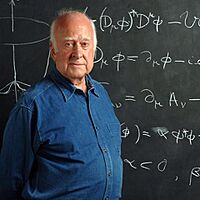
As of October 2024, 20 Nobel Prize winners have been connected to the University of Edinburgh. These include:
- Max Born, a key figure in quantum mechanics
- Peter Higgs, who helped explain how particles get mass
- Geoffrey Hinton, a leader in artificial intelligence
- Sir Fraser Stoddart, a chemist
- Peter C. Doherty, an immunologist
- Sir James Mirrlees, an economist
- Richard Henderson, a pioneer in studying tiny structures
- Sir Robert Edwards, who helped develop in-vitro fertilization
Other important award winners linked to the university include Turing Award winners and a Fields Medalist.
Heads of State and Government
Many leaders of countries and governments have studied at the University of Edinburgh. These include:
- Harini Amarasuriya, the current Prime Minister of Sri Lanka
- Hastings Banda, former Prime Minister and President of Malawi
- Gordon Brown, former Prime Minister of the United Kingdom
- John Swinney, the current First Minister of Scotland
- Julius Nyerere, former President of Tanzania
- Lord Palmerston, former Prime Minister of the United Kingdom
See also
 In Spanish: Universidad de Edimburgo para niños
In Spanish: Universidad de Edimburgo para niños


